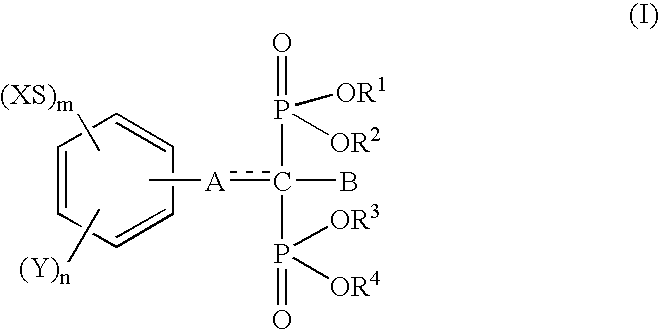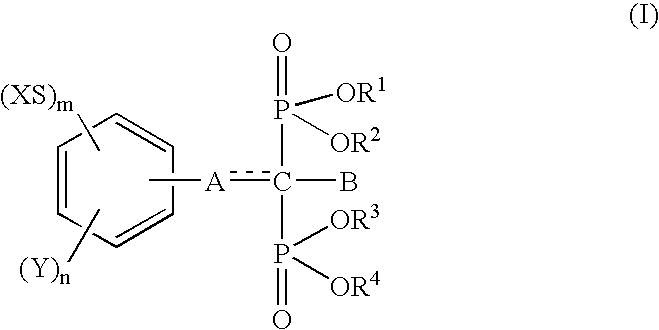Drugs for periodontal disease
a periodontal disease and periodontal disease technology, applied in the field of periodontal disease drugs, can solve the problems of ineffective long-term treatment, tooth loss in adults, and ineffective 4-amino-1-hydroxybutylidene-1,1-bisphosphonic acid for the formation of dental pocket, and achieve the effect of suppressing the infiltration of inflammatory cells
- Summary
- Abstract
- Description
- Claims
- Application Information
AI Technical Summary
Benefits of technology
Problems solved by technology
Method used
Image
Examples
example 1
Inhibition of Infiltration of Inflammatory Cells to Periodontal Tissues of Rat Model with Periodontal Disease
The following pharmacological test was performed using disodium (4-methylthiophenyl)thiomethane-1,1-bisphosphonate (hereinafter referred to as "Compound 1") as a test drug. The following procedure was performed in order to induce an inflammatory alteration in the periodontal tissue of rats. Specifically, a nylon suture (No. 3-0) was inserted into the interdental part between the maxillary right first molar tooth and the second molar tooth of a Wistar strain male rat of 4 weeks of age, and this side was defined as the test side (hereinafter referred to as "nylon suture inserted side"). Small knots were formed at both ends of the nylon suture in order to avoid the nylon suture from dropping off during the test period. Separately, nothing was inserted into the interdental part between the maxillary left first molar tooth and the second molar tooth, and this side was defined as t...
example 2
Inhibition of Alveolar Bone Resorption in Rat Model with Periodontal Disease
In order to histomorphometrically examine the severity of the resorption of the alveolar bone, an image of the tissue section used in Example 1 was projected onto the tablet of an image analyzer, and the shortest straight line from the median of a line to the alveolar bone cupulate part was drawn to thereby measure the distance thereof, which line linked between the cementum-enamel junctions on the distal side of the maxillary first molar tooth and on the mesial side of the.second molar tooth. In the histomorphometrical examination, each one individium was sampled from each group and three tissue sections per individium were used.
The results obtained from three tissue sections are shown as means in Table 3 and Table 4.
TABLE 4
As apparent from Tables 3 and 4, Compound 1 inhibited the resorption of the alveolar bone, which were induced and proceeded from the fourth week until the eighth week after the insertion...
example 3
Inhibition of Gingival Recession in Rat Model with Periodontal Disease
In order to histomorphometrically examine the length of exposed cementum, which indicates the degree of gingival recession, an image of the tissue section used in Example 1 was projected onto the tablet of an image analyzer, and the lengths between the cementum-enamel junction to the attached part of the gingiva on the distal side of the maxillary first molar tooth and on the mesial side of the second molar tooth, and the mean of the both was calculated. In the histomorphometrical examination, each one individium was sampled from each group and three tissue sections per individium were used.
The results obtained from three tissue sections are shown as means in Table 5 and Table 6.
TABLE 6
As apparent from Tables 5 and 6, Compound 1 inhibited the gingival recession, which were induced and proceeded from the fourth week until the eighth week after the insertion of the nylon suture.
PUM
| Property | Measurement | Unit |
|---|---|---|
| depth | aaaaa | aaaaa |
| vascular permeability | aaaaa | aaaaa |
| mechanical | aaaaa | aaaaa |
Abstract
Description
Claims
Application Information
 Login to View More
Login to View More - R&D
- Intellectual Property
- Life Sciences
- Materials
- Tech Scout
- Unparalleled Data Quality
- Higher Quality Content
- 60% Fewer Hallucinations
Browse by: Latest US Patents, China's latest patents, Technical Efficacy Thesaurus, Application Domain, Technology Topic, Popular Technical Reports.
© 2025 PatSnap. All rights reserved.Legal|Privacy policy|Modern Slavery Act Transparency Statement|Sitemap|About US| Contact US: help@patsnap.com



